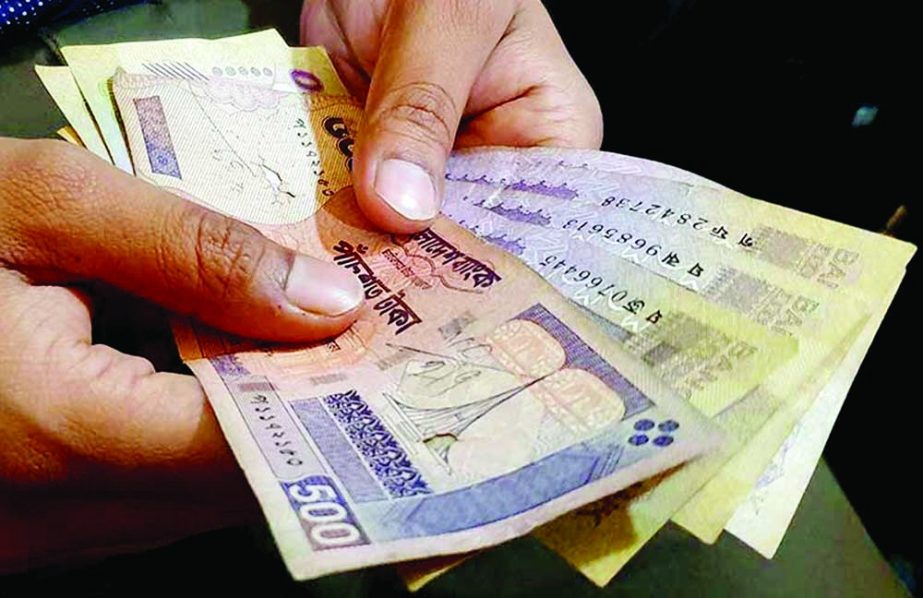
Al Amin :
The value of Bangladeshi Taka continued to erode against the US dollar in the interbank market amid higher current account deficit and import bills.
From September 2020 to January 2022, the Bangladeshi currency had lost its value by Tk 1.20 or 1.41 per cent against the US dollar, according to media reports.
Besides, the domestic currency lost its value by Tk 1.40 from July-March 27 of this fiscal year.
On Sunday, per dollar was traded at Tk 86.20 on the interbank foreign-exchange market and the US dollar was quoted Tk 84.80 on July 5 of this fiscal year in the official channel.
Yesterday, the greenback was selling at Tk 92 at the open or kerb market, which is the highest ever.
On January 6 this year, one had to spend Tk 85.80 per dollar in the inter-bank currency market.
Analysts said the erosion in the value of taka would lead to more inflation in the domestic consumer market and affect the general public.
They said the Bangladesh currency could lose its value against US dollar further in this financial year due to an expected higher current account deficit.
“There is no alternative but devaluation of local currency in the wake of surging trade deficit. How ever the devaluation of Bangladeshi currency against the US dollar would have to be in controlled way,”said economist Dr Zahid Hussain.
He said, if the gap between the open market and official rate of dollar is high, then it will encourage illegal transactions from the exports
proceeds and inward remittances.
He stated that the gap between the official and open market rate of dollar should not be more than Tk 2 to Tk 2.5. “The existing gap is now little bit high. The government agencies should keep a close watch on foreign market for the interest of the national economy,” he noted.
When asked, Dr Zahid, former lead economist at the World Bank’s Dhaka office, said, “The demand for the US dollar increases because of higher import bills and subsequently, it weakens the local currency.”
He added, “Importers will bear the brunt of depreciating taka. However, it is a boon for the exporters as they receive more taka in exchange for dollars.”
Dr Zahid further said imports will become costlier due to depreciation of local currency. On the other hand, imported goods will be expensive and it will fuel inflation.
“The rise in inflation will reduce savings of the people. This will negatively impact the country’s economy because savings and investments are extremely important for economic growth,” he added.
Bangladesh’s total imports from July, 2021 to January, 2022 were $45.48 billion. The amount was $29.82 billion during the corresponding period of the previous fiscal year, according to the central bankstatistics.
As per the statistics, the imports have increased by 52.50 per cent during the period.
Besides, the country’s current-account deficit rose to $10.06 billion during the July-January period of fiscal year (FY) 2021-22. It was a $1.56 billion surplus in the same period of FY21.
“The rise in the US currency in the interbank was happening as importers were booking dollars in advance order to meet their rising import bill, leading to an increase in its demand,” economist Dr Ahsan H Mansur told The New Nation.
He said the dollar has been appreciating against the taka since July because of a number of reasons, including the rising import as a result of renewed economic activities after Covid-19 shocks, soaring food, commodity and oil prices and an international geo-political tensions triggered Russia’s invasion of Ukraine.
“The exporters would get benefit against their export proceeds but the importers would face a tough time as the cost has been increasing and ultimately it will hurt consumption, which is the main wheel of the Bangladesh economy,” he noted.
Meanwhile, the central bank continues to provide foreign currency liquidity support to the commercial banks to settle their import-payment obligations.
It has so far sold $3.73 billion from foreign reserves directly to commercial banks as liquidity support for settling their import-payment obligations in the current fiscal year (FY), 2021-22.

